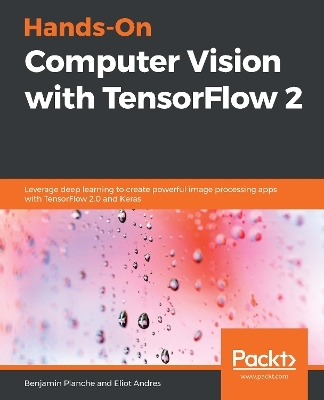
Hands-On Computer Vision with TensorFlow 2
Packt Publishing Limited (Verlag)
978-1-78883-064-5 (ISBN)
A practical guide to building high performance systems for object detection, segmentation, video processing, smartphone applications, and more
Key Features
Discover how to build, train, and serve your own deep neural networks with TensorFlow 2 and Keras
Apply modern solutions to a wide range of applications such as object detection and video analysis
Learn how to run your models on mobile devices and web pages and improve their performance
Book DescriptionComputer vision solutions are becoming increasingly common, making their way into fields such as health, automobile, social media, and robotics. This book will help you explore TensorFlow 2, the brand new version of Google's open source framework for machine learning. You will understand how to benefit from using convolutional neural networks (CNNs) for visual tasks.
Hands-On Computer Vision with TensorFlow 2 starts with the fundamentals of computer vision and deep learning, teaching you how to build a neural network from scratch. You will discover the features that have made TensorFlow the most widely used AI library, along with its intuitive Keras interface. You'll then move on to building, training, and deploying CNNs efficiently. Complete with concrete code examples, the book demonstrates how to classify images with modern solutions, such as Inception and ResNet, and extract specific content using You Only Look Once (YOLO), Mask R-CNN, and U-Net. You will also build generative adversarial networks (GANs) and variational autoencoders (VAEs) to create and edit images, and long short-term memory networks (LSTMs) to analyze videos. In the process, you will acquire advanced insights into transfer learning, data augmentation, domain adaptation, and mobile and web deployment, among other key concepts.
By the end of the book, you will have both the theoretical understanding and practical skills to solve advanced computer vision problems with TensorFlow 2.0.
What you will learn
Create your own neural networks from scratch
Classify images with modern architectures including Inception and ResNet
Detect and segment objects in images with YOLO, Mask R-CNN, and U-Net
Tackle problems faced when developing self-driving cars and facial emotion recognition systems
Boost your application's performance with transfer learning, GANs, and domain adaptation
Use recurrent neural networks (RNNs) for video analysis
Optimize and deploy your networks on mobile devices and in the browser
Who this book is forIf you're new to deep learning and have some background in Python programming and image processing, like reading/writing image files and editing pixels, this book is for you. Even if you're an expert curious about the new TensorFlow 2 features, you'll find this book useful.
While some theoretical concepts require knowledge of algebra and calculus, the book covers concrete examples focused on practical applications such as visual recognition for self-driving cars and smartphone apps.
Dr. Benjamin Planche is a passionate research scientist in computer vision and machine learning. His main research efforts focus on data scarcity problems and industrial vision systems, leading to numerous patents and publications at international conferences. He worked in various research labs around the world (including in France, Japan, Germany, and the USA). Benjamin obtained his Ph.D. summa cum laude from the Faculty of Computer Science and Mathematics at the University of Passau, under the supervision of Prof. Dr. Harald Kosch. He also has a double master's degree from INSA-Lyon (France) and the University of Passau (Germany), with first-class honors and a multinational excellence award. He also likes sharing his knowledge and experience on various platforms or applying them to the creation of aesthetic demos. Eliot Andres is a freelance deep learning and computer vision engineer. He has more than 3 years' experience in the field, applying his skills to a variety of industries, such as banking, health, social media, and video streaming. Eliot has a double master's degree from École des Ponts and Télécom, Paris. His focus is industrialization: delivering value by applying new technologies to business problems. Eliot keeps his knowledge up to date by publishing articles on his blog and by building prototypes using the latest technologies.
Table of Contents
Computer Vision and Neural Networks
TensorFlow Basics and Training a Model
Modern Neural networks
Influential Classification Tools
Object Detection Models
Enhancing and Segmenting Images
Training on Complex and Scarce Datasets
Video and Recurrent Neural Networks
Optimizing Models and Deploying on Mobile Devices
Appendix
| Erscheinungsdatum | 05.06.2019 |
|---|---|
| Verlagsort | Birmingham |
| Sprache | englisch |
| Maße | 75 x 93 mm |
| Themenwelt | Mathematik / Informatik ► Informatik ► Programmiersprachen / -werkzeuge |
| Informatik ► Theorie / Studium ► Künstliche Intelligenz / Robotik | |
| ISBN-10 | 1-78883-064-4 / 1788830644 |
| ISBN-13 | 978-1-78883-064-5 / 9781788830645 |
| Zustand | Neuware |
| Haben Sie eine Frage zum Produkt? |
aus dem Bereich


